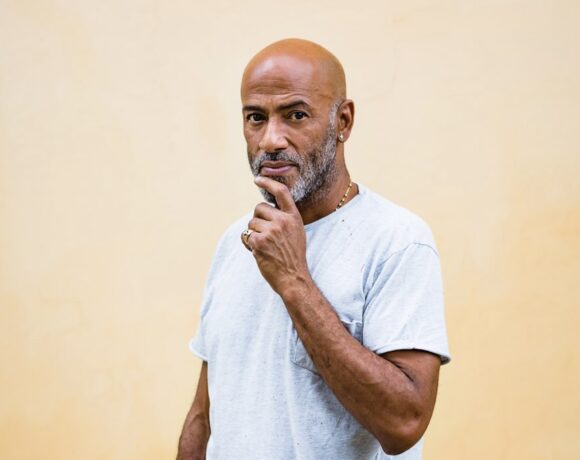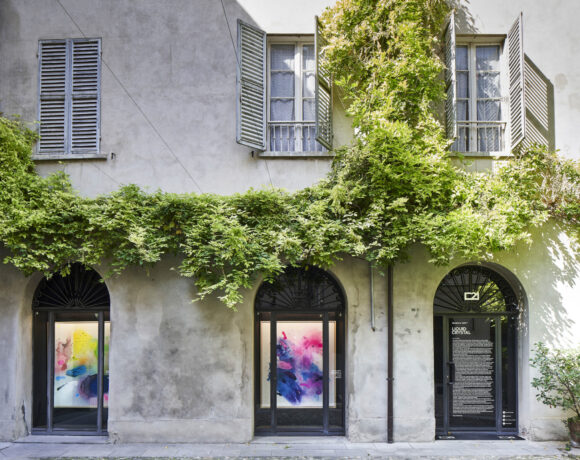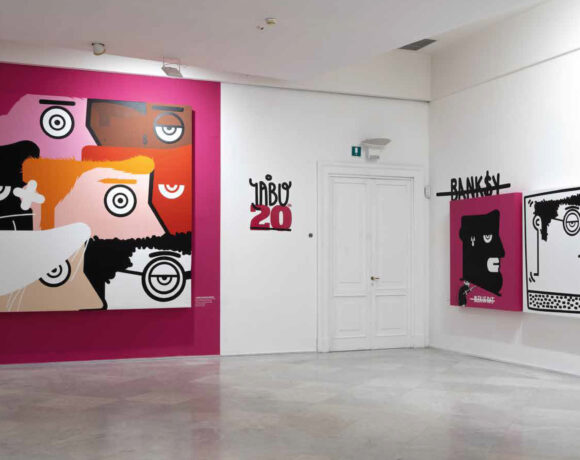The Hub/Art gallery in Milan is currently hosting Marco Abrate’s “Hidden Images” exhibition, open until 10 January 2022. We met the artist at the exhibition space, where immediately on entering you can see how the layout and arrangement of works and objects suggest a gradual approach, almost by clues, to his work.
Greta Zuccali: The exhibition talks about things, or rather about unveiled images, as we immediately get from the title. Can you explain what these Hidden Images are and where they come from?
Marco Abrate: The work, which took the name “Unveilings”, was born in 2016. I developed it after a wonderful trip to China in 2019. That trip, from the tip of the Shanghai Tower to the ruins of the Old Summer Palace in Beijing, to the bamboo forests in the mountains of Zhejiang, changed my life. The beauty of diversity and awareness has taught me a lot. I felt like ‘Tintin’, one of my favourite cartoons on a continuous adventure and quest. I have always been lucky enough to travel around Europe with my family, but this was the first time I had travelled so far on my own. My “walls” come from my perception of the things around me. I have always had an overall view, as quantum physics teaches. In my works, I tell the complexity of the contemporary world, taking the use of materials almost to zero. A very complex discourse that I refine every day, a good method to be faithful to an immense thought. This triggers the effort to achieve awareness and progress towards understanding my work. Because the best results require the greatest patience and a great deal of time.
As you walk through the exhibition space, you notice a bucket, a trolley and some rubble scattered around. These are further indications of making art in an authentic way, getting your hands dirty, which remind us of the Greek τέχνη [téchne], which represented the ability to make art mechanically as well as with the spirit. Where does this way of making art, so material and conceptual at the same time, come from?
From the study to which I dedicate myself every day and from trying to materially translate it and shape it. Thought and action coexist. Turin has taught me how important study and method are in one’s work. Endless perseverance. With the evolution of digital technology, authenticity is becoming increasingly important. In the age of immediacy and mass reproducibility, it is as if life were “living” there, rather than the other way around. The age of the fourth revolution, the digital revolution, creates an enormous additional illusion, namely the failed quest for immortality.
At the entrance to the exhibition space, a spray can also stands out on a column, revealing to us that you have been practising street art since high school. Can you tell us how this path as a “street” artist has evolved and how you are not actually a traditional street artist?
It all started with a skateboard. Then came graffiti and street art: but just doing lettering with spray paint and a fire extinguisher wasn’t enough! The graffiti “missions” were great: you wanted to paint on a roof, you found a way to get there, the same goes for train carriages and the peeling walls of abandoned buildings. I think that’s where the walls started to tell me something. It was always an adventure: I loved to paint while listening to Bach or Beethoven instead of rappers like Nas or N.W.A. (I did this when I was going to school with my skate). I wanted to say more because everything around us is always changing and I did not like feeling trapped in a time that was ended for me. Walls and trains have a great language but I found it limited. I wanted to go further. To do something different, to create other spaces. So I cut a piece of wall and exhibited it in the gallery. The seed started the path of “Disvelamenti”, the walls that are now on display at my first solo exhibition in Milan at the Hub/Art Gallery. I am very grateful to the art critic Giorgio Bonomi who wrote the critical text and encouraged me.
What struck me about you as an artist and a young man is your “soft” approach to work and your approach to people and opportunities. You do not seem to take yourself too seriously, even though you have a steady gaze focused on your goals. Can you tell us about it?
I think that if a person gets too attached to his activity, he/she will not create anything lasting. I was very surprised by a question some collectors asked me during the exhibition. I was asked several times which of my works I was most attached to. I always answered: ‘None’. I try to look at my path in a detached way. If you get too close, you delude yourself and don’t recognise what you are doing. Why? I’ll give you an example playing with gravity. If we hold an arm upwards and if we hold a coin in our fist with the back of the hand upwards and open the hand, the coin falls to the ground. That’s why you don’t let go. But there is another possibility, letting go without losing anything. The arm is still outstretched but with the back of the hand downwards. When you open your hand, the coin remains in your palm: you let go and the coin remains yours. The exhilarating truth of William Blake’s words: “Who binds to himself a joy / does the winged life destroy / who kisses the joy as it flies / lives in eternity’s sunrise”.
Going back to the wall work, do you think you will develop this series further or do you want to concentrate on new projects?
I want to focus very much on this series because many paths can be opened. I focus on one direction, to communicate better with people through my works, otherwise I would risk dispersion and I would stray from the initial point without making myself understood. The pandemic has encouraged the deepening and evolution of this discourse. The funny side is that I wanted to create another path parallel to “Unveilings”: the “Pink”, born in 2017. In itself, it does not exist as a discourse, the public has seen very few works, they are mainly seen in the media that become part of the work. On the street, in the analogue world, the work lasts a short time as it is destroyed, stolen or seized. The world of social media further elevates the illusory concept of “Simply appear” to quote a film. Isn’t this very ephemeral? Yes, the “Pink” appears but does not exist. But it does exist. So which of the two discourses can be defined as “more real”? The decision is up to the audience. In themselves, “Unveilings” and “Pink” are very similar.
Before concluding, I would like you to tell us about a book that you consider fundamental for your training and personal growth.
There is one book, but I don’t want to reveal it. However, I do want to mention another one: a novel by Björn Larsson: “The True Story of the Pirate Long John Silver”. Wonderful!
In conclusion, we can say that Marco Abrate’s work is a continuous game of cross-references. An investigation into the relationship between reality and invention, the thirst for life and the need for immortality, solitude and freedom, with the awareness that there is no other real life than the one we tell ourselves.
Info:
Hidden Images by Marco Abrate
Until January 10, 2022
curated by Greta Zuccali; critical text by Giorgio Bonomi
c/o Hub/Art
Via Privata Passo Pordoi 7/3 Milano
 Marco Abate, Hidden Images, overview courtesy Hub/Art @McVector Ltd
Marco Abate, Hidden Images, overview courtesy Hub/Art @McVector Ltd
 Marco Abrate, La vita possibile, courtesy Hub/Art @McVector Ltd
Marco Abrate, La vita possibile, courtesy Hub/Art @McVector Ltd
![]() Marco Abate, Riconoscersi, courtesy Hub/Art @McVector Ltd
Marco Abate, Riconoscersi, courtesy Hub/Art @McVector Ltd
![]() Marco Abate, Riconoscersi (detail), courtesy Hub/Art @McVector Ltd
Marco Abate, Riconoscersi (detail), courtesy Hub/Art @McVector Ltd
 Marco Abate, Il Coniglio della Paura, courtesy Hub/Art @McVector Ltd.
Marco Abate, Il Coniglio della Paura, courtesy Hub/Art @McVector Ltd.
 Marco Abate, Il Coniglio della Paura (detail), courtesy Hub/Art @McVector Ltd.
Marco Abate, Il Coniglio della Paura (detail), courtesy Hub/Art @McVector Ltd.

Art consultant and curator focused on modern and contemporary art. Trained in law and Master in Art Market Management, she has founded the Hub/Art exhibition space in Milan in 2017. She currently lives between Milan and Paris where she collaborates with galleries and spaces dedicated to contemporary art.






NO COMMENT